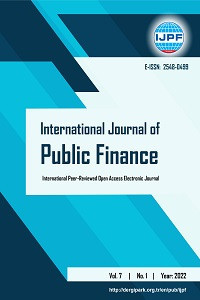Yerel Yönetimler Ekonomisinde Yatay Eşitsizlik Sorununa ve Çözümüne Dair Teorik Bir İnceleme
Çalışma, yerel yönetimler ekonomisinde var olan yatay eşitsizlik sorunu ile çözümünü teorik olarak incelemekte ve bu soruna teorik çözüm aramaktadır. Yatay eşitsizlik sorunu, yerel yönetimler ekonomisinde yerel kamusal mal üretici birimleri açısından oldukça önemli bir sorundur. Yatay eşitsizlik, yerel kamusal mal üretici birimlerinin fazladan harcama ihtiyaçlarının bulunması ya da kaynak bulabilme yeteneklerinin birbirinden farklı olması anlamına gelmektedir. Yatay eşitsizliğe neden olan faktörler, harcama yönü açısından talep etkisi, maliyet etkisi ve taşma etkisi; vergi kapasitesi yönü açısından ise bölgelerarası gelir farklılığı, düşük gelirli grupların yoğunlaşması ve vergi toplama isteksizliği olarak gösterilir. Yatay eşitsizlik, vergi kapasitesi yönü ve harcama ihtiyacı yönü olmak üzere iki yönlü olarak tespit edilir. Yatay eşitsizliğin çözümü, ideal idareler arası yatay mali ilişki programlarının dizayn edilmesi ve dezavantajlı alanlarda yaşayan bireylerin kamusal hizmetlerden eşit düzeyde yararlandırılmasını gerektirir. Şartsız transferler, yatay eşitsizliği çözücü transfer türü olarak gösterilir. Ancak yatay eşitsizlik sorununun çözümü çeşitli iktisadi ve mali sorunlara neden olabilir. Bu yüzden yatay eşitsizliği çözücü kamu politikası oluşturulurken geniş perspektiften konu ele alınmalıdır.
Anahtar Kelimeler:
Yerel Yönetimler Ekonomisi, Yatay Eşitsizlik, Şartsız Transferler
A Theoretical Review on the Horizontal Inequality Problem and Solution in the Local Government Economics
The study examines theoretically the horizontal inequality problem of and its solution and seeks a theoretical solution to this problem. The horizontal inequality problem is a very important problem for the local public goods producer units in local government economics. Horizontal inequality means that the local public goods producer units have extra spending needs or the ability to find resources is different. The factors that cause horizontal inequality are demand effect, cost effect and overflow effect in terms of expenditure direction. In terms of tax capacity, the factors that cause horizontal inequality are shown as inter-regional income difference, the concentration of low-income groups and unwillingness to collect taxes. The horizontal inequality is determined in two ways as tax capacity and expenditure need directions. The solution of horizontal inequality requires the design of ideal horizontal fiscal relations programs between administrations and the equal utilization of public services by individuals living in disadvantaged areas. The unconditional transfers are referred to as the horizontal inequality transfer solvent type. However, the solution to the horizontal inequality problem can lead to various economic and fiscal problems. Therefore, the issue of a broad perspective should be taken into consideration when formulating public policy to solve horizontal inequality.
___
- Bailey, J.S. (1999). Local Government Economics, London: Macmillan Press Ltd.
- Bruce, N. (2001). Public Finance and the American Economy, Boston: Addison Wesley.
- Dahlby, B. (2011). “The Marginal Cost of Public Funds and the Flypaper Effect”, Int Tax Public Finance, 18, 304-321.
- Due, J.F. & Friedlaender, A.F. (1977). Government Finance Economics of the Public Sector, Sixth Edition, Richard D. Irwin Inc.
- Grossman, P.J. (1987). “A Political Theory of Intergovernmental Grants”, The University of Adelaide, Working Paper 87-6.
- Holcombe, R.G. (2006). Public Sector Economics: The Role of Government in the American Economy, Pearson Education.
- Hyman, D.N. (1990). Public Finance, Chicago: The Dryden Press.
- Ladd, H.F. (2005a). “Fiscal Disparities”, The Encyclopedia of Taxation And Tax Policy (ed. Cordes J.J., Ebel R.D., Gravelle J.G.), Washington: The Urban Institute Press.
- Ladd, H.F. (2005b). “Fiscal Equalization”, The Encyclopedia of Taxation And Tax Policy (ed. Cordes J.J., Ebel R.D., Gravelle J.G.), Washington: The Urban Institute Press.
- Litvack, J. ve Seddon, J. (2004). Desantralization Briefing Notes, World Bank Institute.
- Ma, J. (1997). Intergovernmental Fiscal Transfer: A Comparison of Nine Countries, World Bank.
- Martin, R. & Sunley, P. (1998). “Slow Convergence? Post-Neoclassical Endogenous Growth Theory and Regional Development”, Economic Geography, 74, 201-227.
- Musgrave, R.A. (1959). Kamu Maliyesi Teorisi (Çev. O. Şener & Y. Methibay), Asil Yayın Dağıtım.
- Neyaptı, B. (2005). “Mali Yerelleşme Aracılığı ile Mali Eşitleme”, Mali Yerelleşme: Yoksulluk ve Bölgesel Eşitsizlik Sorunlarının Çözümü İçin Yeni Yaklaşım, İstanbul: TESEV Yayınları, 104-127.
- Oates, W.E. (1999). “An Essay on Fiscal Federalism”, Journal of Economic Literature, September, 37(3), 1120-1149.
- Oates, W.E. (2006). “The Many Faces of Tiebout Model, The Tiebout Model at Fifty” (ed. Fischel W.A.), Cambridge MA: Lincoln Institute of Land Policy, 21-45.
- Özel, M. (2009). “Avrupa Birliği’ne Uyum Sürecinde Türkiye’de Bölgelerarası Dengesizlik ve Yeni Yönetsel Birim Arayışları”, Ankara Üniversitesi SBF Dergisi, 64(01), 165-199.
- Öztürk, L. (2006). “Geçiş Ekonomilerinde Bölgelerarası Dengesizlikler: Bir Neden Olarak Piyasa Ekonomisi”, Manas Üniversitesi Sosyal Bilimler Dergisi, Sayı: 16, 21-35.
- Sağbaş, İ. & Bağdigen, M. (2003), Local Government Finance in Turkey, İstanbul Metropolitan Municipality, Directorate for Research.
- Shah, A. (2007). “A Practitioner’s Guide to Intergovernmental Fiscal Transfers”, Intergovernmental Fiscal Transfers (ed. Boadway, R. ve Shah, A.)
- Stiglitz, J.E. (2000). Economics of the Public Sector, New York: W.W. Norton Company.
- Tekeli, R., Acartürk, E. & Görmüş, Ş. (2005). “İdarelerarası Mali Yardım Dağıtım Sisteminin Yeniden Yapılandırılması ve Bütçenin Mali Yardım Yoluyla Türkiye’de Bölgelerarası Eşitsizliğe/Gelir Dağılımına Etkisi”, 20. Türkiye Maliye Sempozyumu.
- Ulusoy, A. & Akdemir, T. (2007). Mahalli İdareler, Ankara: Seçkin Yayınevi.
- Uzay, N. (2005). Bölgesel Gelişmişlik Farklarının Giderilmesi ve Bölgesel Kalkınma Ajansları, Ankara: Seçkin Yayınları.
- Yılmaz, S. (2003). “Intergovernmental Transfers: Concepts and Policy Issues”, World Bank Institute, WB177898.
- Yayın Aralığı: Yılda 2 Sayı
- Başlangıç: 2016
- Yayıncı: Adnan GERÇEK
Sayıdaki Diğer Makaleler
Türkiye’de ve Bazı Ülkelerde Vergi Karmaşıklığının Karşılaştırmalı İncelenmesi
Nizâmü’l Mülk’ün “Siyasetnâme” İsimli Eserindeki Malî Konuların Tespiti ve Değerlendirilmesi
Kamu Hizmetlerinin Sunum ve Finansmanında Kamu Özel İşbirliği Modeli: Avrupa Birliği ve Türkiye
Psychological and Sociological Factors Weakening Public Budget Awareness
Yerel Yönetimler Ekonomisinde Yatay Eşitsizlik Sorununa ve Çözümüne Dair Teorik Bir İnceleme
OECD ve Seçilmiş Bazı Ülkelerde Dijital Ekonominin Vergilendirilmesi: Türkiye İçin Çıkarımlar
